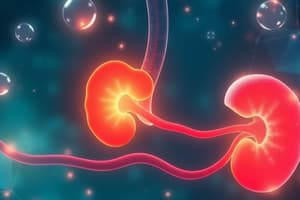Podcast
Questions and Answers
What is the primary cause of Diabetes Insipidus?
What is the primary cause of Diabetes Insipidus?
- Deficiency or inability to respond to ADH (correct)
- Excessive production of ADH
- Impact of external factors on kidney function
- Hormonal overproduction from the adrenal glands
Dipsogenic DI is primarily caused by a defect in ADH production.
Dipsogenic DI is primarily caused by a defect in ADH production.
False (B)
What condition could result from untreated Diabetes Insipidus?
What condition could result from untreated Diabetes Insipidus?
Cardiac arrest and death
In Nephrogenic DI, the renal tubules do not respond to _____, leading to inadequate water reabsorption.
In Nephrogenic DI, the renal tubules do not respond to _____, leading to inadequate water reabsorption.
Which of the following symptoms is associated with Diabetes Insipidus?
Which of the following symptoms is associated with Diabetes Insipidus?
Match the classifications of Diabetes Insipidus with their descriptions:
Match the classifications of Diabetes Insipidus with their descriptions:
What laboratory finding indicates Diabetes Insipidus in a 24-hour urine output test?
What laboratory finding indicates Diabetes Insipidus in a 24-hour urine output test?
Patients with Diabetes Insipidus often experience weight gain due to fluid retention.
Patients with Diabetes Insipidus often experience weight gain due to fluid retention.
Which treatment is commonly prescribed for neurogenic Diabetes Insipidus?
Which treatment is commonly prescribed for neurogenic Diabetes Insipidus?
Patients with Diabetes Insipidus should monitor their daily weight and intake/output.
Patients with Diabetes Insipidus should monitor their daily weight and intake/output.
What is one potential cause of the Syndrome of Inappropriate Antidiuretic Hormone (SIADH)?
What is one potential cause of the Syndrome of Inappropriate Antidiuretic Hormone (SIADH)?
The main hormone involved in the water retention process in Diabetes Insipidus is called ___.
The main hormone involved in the water retention process in Diabetes Insipidus is called ___.
Match the following treatments with their appropriate condition:
Match the following treatments with their appropriate condition:
Which of the following is NOT a sign of water intoxication in patients?
Which of the following is NOT a sign of water intoxication in patients?
What should patients taking long-term desmopressin expect to monitor regularly?
What should patients taking long-term desmopressin expect to monitor regularly?
Thiazide diuretics are used in SIADH management to help decrease sodium levels.
Thiazide diuretics are used in SIADH management to help decrease sodium levels.
What is a common symptom of hyponatremia?
What is a common symptom of hyponatremia?
Weight gain without edema is a symptom of water intoxication.
Weight gain without edema is a symptom of water intoxication.
What type of saline is used in the medical treatment for acutely ill patients with hyponatremia?
What type of saline is used in the medical treatment for acutely ill patients with hyponatremia?
A key diagnostic test for SIADH involves measuring urine and serum ______ and ______.
A key diagnostic test for SIADH involves measuring urine and serum ______ and ______.
Match the following symptoms with their corresponding condition:
Match the following symptoms with their corresponding condition:
Which treatment is recommended for managing fluid intake in hyponatremia?
Which treatment is recommended for managing fluid intake in hyponatremia?
What can be a severe outcome if the central nervous system is affected by water intoxication?
What can be a severe outcome if the central nervous system is affected by water intoxication?
What laboratory finding is indicative of SIADH?
What laboratory finding is indicative of SIADH?
Flashcards are hidden until you start studying
Study Notes
Diabetes Insipidus (DI)
- Characterized by excessive production of dilute urine.
- Three classifications:
- Nephrogenic DI: Renal tubules fail to respond to antidiuretic hormone (ADH), preventing water reabsorption.
- Neurogenic DI: Defects in ADH production or secretion, impacting water balance.
- Dipsogenic DI: Caused by abnormally stimulated thirst, leading to increased water intake and reduced vasopressin secretion.
Pathophysiology of DI
- Results from ADH deficiency or renal insensitivity to ADH, leading to large volumes of dilute urine excretion.
Signs and Symptoms of DI
- Massive diuresis and dehydration can lead to hypotension, circulatory collapse, and intense thirst.
- Additional symptoms include malaise, lethargy, and irritability.
- Untreated DI can progress to cardiac arrest and potentially death.
Medical Diagnosis of DI
- Involves health history, physical examination, and lab tests.
- A 24-hour urine output exceeding 4 liters indicates DI, with low urinary osmolality and specific gravity.
Treatment for Diabetes Insipidus
- Intravenous fluid replacement and vasopressors might be required to manage blood pressure.
- Neurogenic DI treated with DDAVP (desmopressin acetate), available in various forms including oral, IV, or nasal inhalation; may need lifelong use.
- Sodium intake may be restricted, and thiazide diuretics can be used to promote water reabsorption.
Patient Education for DI
- Instruct patients to monitor weight and input/output daily.
- Watch for signs of water intoxication, such as drowsiness and headache.
- Regularly test urine specific gravity.
- Emphasize adherence to prescribed medications and discuss potential side effects of prolonged nasal spray use.
- Recommend scheduling rest periods during activities.
Syndrome of Inappropriate Antidiuretic Hormone (SIADH)
- Caused by excessive ADH production or secretion, leading to water retention.
- Contributing factors: brain trauma, surgery, tumors, infections, and certain medications such as vasopressin or tricyclic antidepressants.
Pathophysiology of SIADH
- Elevated ADH levels despite normal/low serum osmolality result in excessive water retention, leading to diluted blood sodium (hyponatremia) and water intoxication.
Signs and Symptoms of SIADH
- Symptoms include weakness, muscle cramps, nausea, diarrhea, irritability, headache, and unexplained weight gain.
- Severe cases may affect consciousness, potentially leading to seizures or coma.
Medical Diagnosis of SIADH
- Diagnosis involves serum and urine electrolyte and osmolality testing.
- A high urine osmolality coupled with low serum osmolality indicates SIADH.
- Imaging studies may identify underlying causes.
Treatment for SIADH
- Acutely ill patients may require hypertonic saline administered slowly over 4 to 6 hours.
- Fluid intake should be restricted to 800-1000 mL/day, with increased dietary sodium to aid in fluid management.
Studying That Suits You
Use AI to generate personalized quizzes and flashcards to suit your learning preferences.




